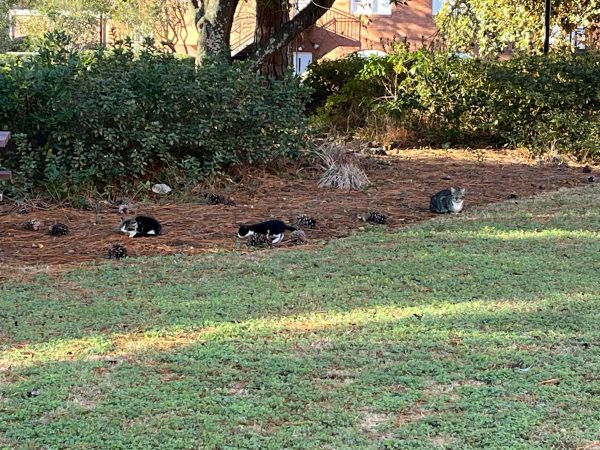Art graduate student creates the life of fictional character from scraps
January 31, 2019
Like a Christmas window display in a Macy’s storefront, the life of August Hermann Kotz is put into view at the front gallery of the Interdisciplinary Academic Building.
Upon stepping inside the exhibit, viewers will first see a man dressed to the nines in a confiscated army suit and necklaces made of animal bones and teeth. Surrounding him is a camp setup and hand-made tools, a tribute to the conditions he lived in, followed by relics of the time period he existed in.
Seeing the pictures of his destroyed family and the reminders of the wonders and horrors he experienced during the course of his life will pull at viewers’ heartstrings and have them googling Kotz for detailed information on his life.
However, even the most extensive Google search will not reveal so much as a year of birth, leaving the search woefully confused.
The simple reason for this is due to the fact that Kotz, the institutionalized naturalist, is a creation of graduated art major Marion Trainor’s imagination.
As far as legal records will show, he never existed.
The creation of Kotz
A multi-skilled artist, Trainor began making random pieces of art and jewelry as part of projects within her major, but wanted the pieces to connect.
“I developed this project for myself mostly as an attempt to keep myself interested in the work I needed to complete for class,” Trainor said. “Churning out endless short term projects only made significant by the weight of a grade quickly lost my attention. This project was completely formed as a carrot on a stick for myself that managed to gain more momentum than expected.”
Thus, Trainor created a story and then a character to tie them together through a descriptive, 102-page thesis.
Detailed throughout the thesis is how Kotz’s story and the over 100 individual artifacts took over three years of research and planning to create. Most of the planning consisted of historical sourcing and transforming each piece to fit the overall project.
Some objects, such as Kotz’s family photos, were part of photo albums sent into an antique shop Trainor frequented. Others, such as a hospital gurney, were gifted to her. Most objects, such as the tools and a toy rabbit, were handmade and treated to give them an “aged” appearance.
“Kotz was created as a way to answer the question ‘why would a person create these things’ and ‘what use do they have,’” Trainor said.
The structure of the character and story of Kotz was inspired by the real deception operation known as Operation Mincemeat, a WWII British ploy to trick Germany by planting false personal and military objects, including fake plans to invade Greece and Sardinia, on a corpse-turned fictional military captain.
“They went as so far as to write love letters for his wife,” Trainor said. “I found that so fascinating because it’s wildly out there. [Kotz] grew out of that.”
The man in the woods
A.H. Kotz was a man who at one time had a calm, natural life with a family and a career in the late 1800s. Through the course of his studies, he found something that should have remained secret, and was subsequently institutionalized by a secret organization into the fictional and inhospitable Durwich Hospital just before the first world war.
Kotz’s family was told that he had been injured to the point of comatose, thus cutting them out of the picture.
Kotz eventually escaped the hospital seven years after his detainment. Unable to reconnect with his family, he gathered the few mementos left in his family home and retreated into woodsy seclusion, his mind and spirit warped from all he had experienced.
“The biggest thing with Kotz was trying to make somebody that was problematic, and had issues, and was kind of crazy but not in a way that made him inhuman,” Trainor said.
The remainder of his days consisted of jumping from camp to camp and obsessively hoarding all he found, never speaking to another human being and becoming near-feral from the isolation.
His remains were found in a cluster of trees near the edge of an overgrown field in 1963, near an abandoned house where a majority of his belongings were kept. Through his things and hospital diary, Kotz’s story could finally be told.
An untold possibility
While the wild man was created out of an art student’s vivid imagination, visitors to his exhibit will be able to witness the growing isolation people are capable of feeling when pushed to extremes.
Like with all fictional characters, there is always an extraordinary chance someone like Kotz may have existed, and by a flicker of luck, they were finally able to have their story told.
“It’s possible Kotz could have existed,” Trainor said. “That was an intentional choice.”
Trainor said that she was interested in continuing Kotz’s story one day, possibly in the form of a podcast or graphic novel.
The exhibit will remain in the IAB until the first week of February.
Shiann Sivell, The George-Anne Enterprise Reporter, gaeditor@georgiasouthern.edu.











